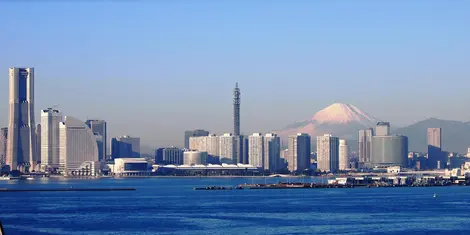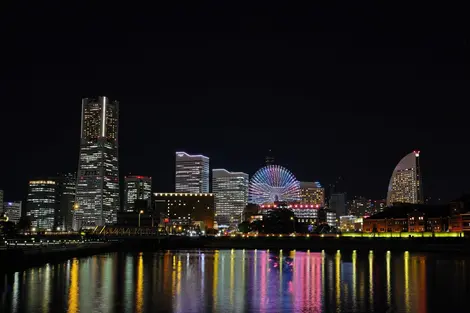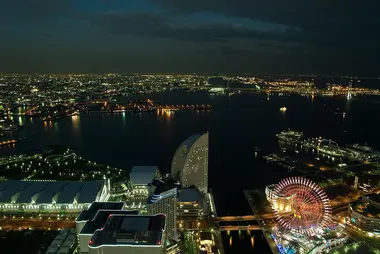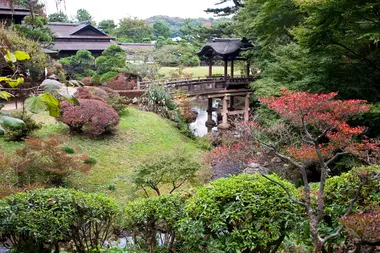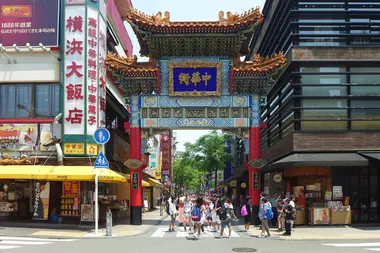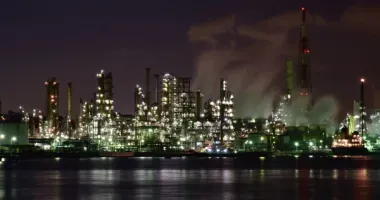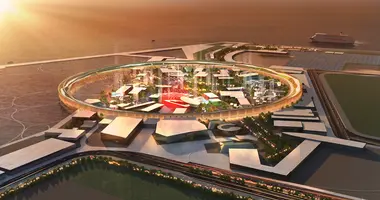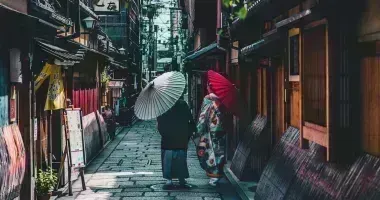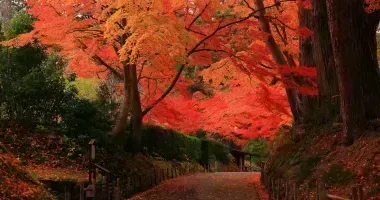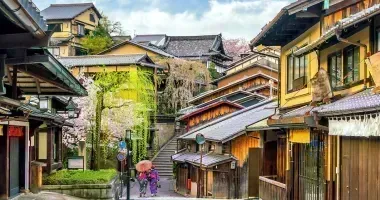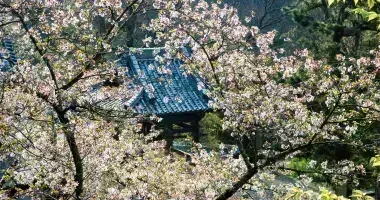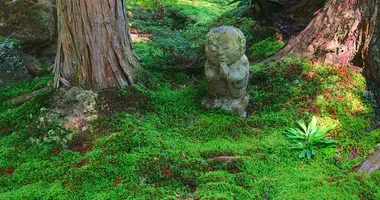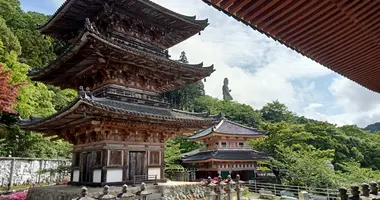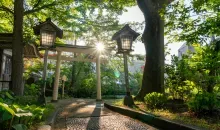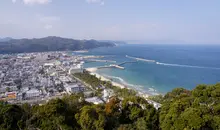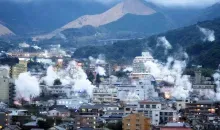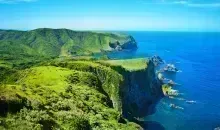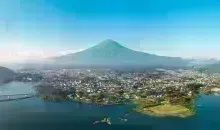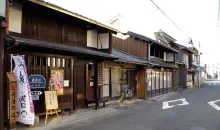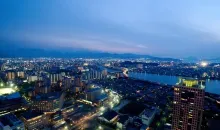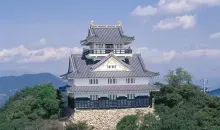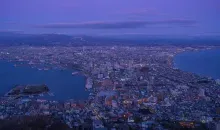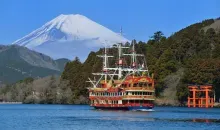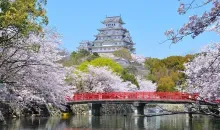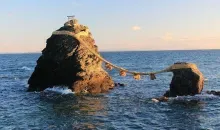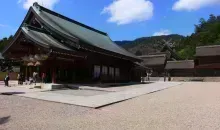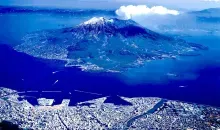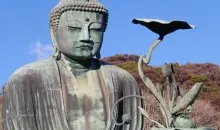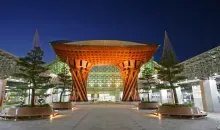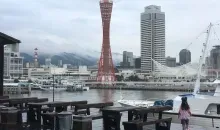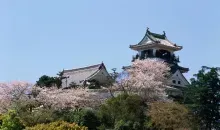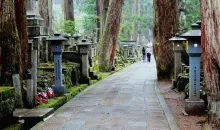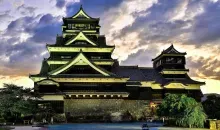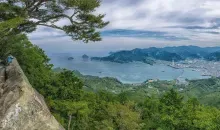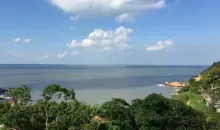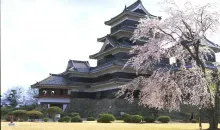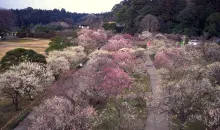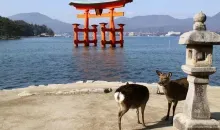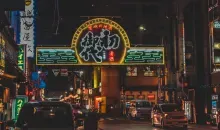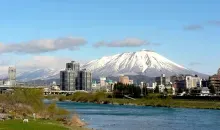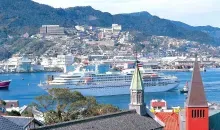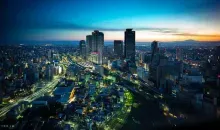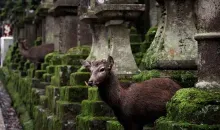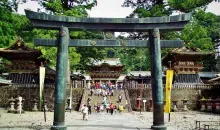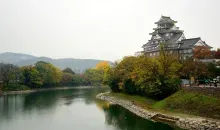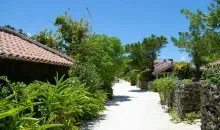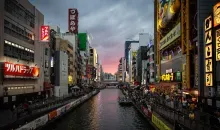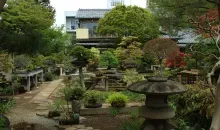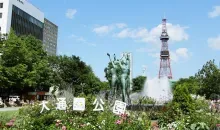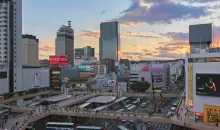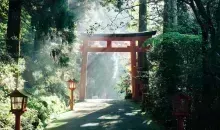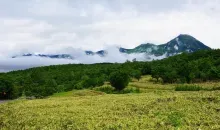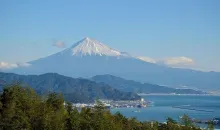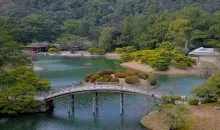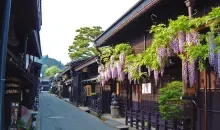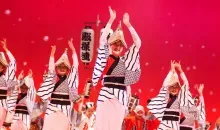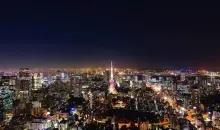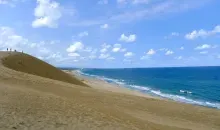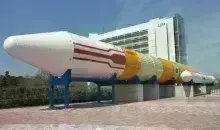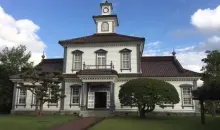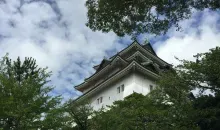Yokohama 横浜
- Published on : 30/03/2020
- by : C.V / J.R.
- Youtube
Local Time 21:22
Symbol : sunny_cloudy
Temp : 31.2°C
Date : Today
Symbol : sunny
Temp : 26.9°C
Date : Tomorrow
Symbol : sunny_cloudy
Temp : 26.8°C
Date : Friday
Symbol : cloudy
Temp : 27°C
Date : Saturday
Local Time 21:22
Symbol : sunny_cloudy
Temp : 31.2°C
Date : Today
Symbol : sunny
Temp : 26.9°C
Date : Tomorrow
Symbol : sunny_cloudy
Temp : 26.8°C
Date : Friday
Symbol : cloudy
Temp : 27°C
Date : Saturday
Visit to do near Tokyo: Yokohama
The small fishing port has grown a lot: today the second largest city in Japan with 3.7 million inhabitants, Yokohama is divided between business districts and foreign communities which give it a unique face. This city which is part of the gigantic megalopolis of Tokyo is easily accessible and offers to discover another face of Japan.
Yokohama Travel Guide
Yokohama, with a population of about 3.5 million people, is Japan's second biggest city, and is the capital of Kanagawa Prefecture. Yokohama is close to Tokyo - about a 30-minute train ride from Shinjuku Station on the Shinjuku Shonan Line to Yokohama Station.
Yokohama is also Japan's second largest port and luxury cruise destination. Historically, the city has been Japan's gateway to the world, giving it something of a cosmopolitan air.
The city's seafront location and pleasant parks also give it a relaxed atmosphere, enhanced by the smattering of historic sites and buildings in the Yamate district.
Yokohama is noted, too, for having Japan's largest and most colorful Chinatown. It is also home to the futuristic Minato Mirai 21 Development on the waterfront.
Yokohama History
Yokohama opened to overseas trade in 1859 - the first time in over two centuries that foreigners were allowed to live and trade on the Japanese mainland. The last time before that was in 1635 when the Dutch were confined to what at the time was Dejima Island in Nagasaki. Moving the Dutch offshore was the final measure of many in the expulsion of foreigners from Japan, which had begun with the expulsion of foreign missionaries in June 1587.
The opening of Yokohama can be traced to the signing in the port of Shimoda of the Treaty of Amity and Commerce (the "Harris Treaty") of July 29 1858 which America, with its military might, forced on Japan - as did other Western powers, each with its own treaty. However the Harris Treaty actually specified nearby Kanagawa, not Yokohama, as the port of extraterritoriality in Tokyo.
The first resident British ambassador to Japan, Rutherford Alcock, arrived in Tokyo on 26 June 1859. Shortly afterwards he discovered that the Japanese government was putting the finishing touches on an elaborate settlement for foreign trade, complete with granite piers and custom house, built at great effort and expense, but on the marshes of what was at that time the tiny fishing village of Yokohama, not the treaty port of Kanagawa.
Kanagawa was on the Tokaido highway, the main thoroughfare between Kyoto and Edo (current day Tokyo), and was therefore ideally suited to quick and easy communications. Yokohama on the other hand was several miles from the Tokaido, and with only a single road for access, making all trade between Yokohama and the rest of Japan easy to monitor and control. At the start, Japanese citizens had to purchase a licence just to access Yokohama.
The Japanese government was adamant in the face of protests by the British ambassador, Alcock, and the American ambassador, Harris. The Japanese government had its hand strengthened by the fact that the foreign merchants, eager to start trading with Japan quickly, moved in to Yokohama with its extensive, ready-made, facilities, oblivious to political wranglings when the long-awaited chance to begin trade with Japan beckoned. The foreign trading community thus lived in Yokohama, while the diplomatic community lived in Kanagawa.
The founding of Yokohama, rather than the treaty port of Kanagawa, as a port of extraterritoriality, was therefore a fait accompli, and this marshy, remote fishing village thus found its place in Japanese history.
How to get from Tokyo to Yokohama?
From Tokyo, it is possible to visit Yokohama's various tourist sites in one day, most of which are between Chinatown and Yokohama Station. The city can be reached by train from Tokyo, in 15 to 40 minutes depending on where you are departing from.
- From Shibuya, take the Tôkyû-Tôyoko line . Price: 280 yen (€ 2 30), 30-minute journey.
- From Shinjuku, take the Shonan-Shinjuku line . Fee: 570 yen (€ 4.80), 30-minute journey.
- From Tokyo Station , take either the Tôkaidô, Yokosuka, or Keihin-Tôhoku lines . Price: 480 yen (€ 4), journey between 25 and 40 minutes.
What to do in Yokohama?
Here are the great must-sees that we recommend in Yokohama:
Minato Mirai 21
Minato Mirai 21 is a grand recreational harborside development centered on the massive Yokohama Landmark Tower, which is one of Japan's biggest buildings. Yokohama Landmark Tower incorporates the Yokohama Royal Park Hotel, with great harbor views, and has a publicly accessible Sky Garden viewing gallery on the 69th floor. This area is also home to many large companies such as Mitsubishi, Nissan and Toshiba.
The Yokohama Port Museum, with its permanently moored and handsomely maintained 1930s sailing ship, is right in front of Yokohama Landmark Tower. The museum traces the history of Yokohama Port, Japan's oldest and largest.
The Yokohama Museum of Artis also next to Yokohama Landmark Tower, on the other side from the Yokahama Port Museum.
The triple-tower Queen's Square shopping, restaurant and hotel complex, too, is right next to Yokohama Landmark Tower. The three towers are arrayed in descending height and include the superb Yokohama Bay Hotel Tokyu. The classical concert space, Yokohama Minato Mirai Hall, is also in Queen's Square.
Pacifico Yokohama is next along from Queen's Square, on the eastern end of the harbor. In spite of being the smallest building on the waterfront in terms of height, it is more of a landmark than the others for its unique, curved, sail-like contours and its prominent location, dominating the waterfront. Pacifico Yokohama comprises a conference center and the luxurious and optimally located Yokohama Grand Intercontinental Hotel.
Shinko Island
Yokohama Cosmoworld amusement park is just across from Pacifico Yokohama, via bridge to small Shinko-cho island. The Cosmo Clock Ferris Wheel is one of the world's largest at 112.5m high and a capacity of 480 people.
For shopping and events, the Akarenga (red-brick) is a bustling retail and entertainment center made up of two restored historic brick warehouses, more chic and varied inside than their exteriors might suggest. World Porters nearby is also popular for its shopping, cinema and restaurant mall.
The Cupnoodles Museum is also on Shinko Island.
Historical Yokohama
Historical Yokohama begins just south of Minato Mirai 21. The northern part of this area preserving notable reminders of the city's past, particularly in relation to its original foreign settlement, is defined by Bashamachi and Kannai subway stations. The southern part is the even more historically rich Motomachi Yamate area.
Bashamachi & Kannai Stations
Bashamachi station on the Minatomirai Subway Line is just south of Minato Mirai 21 - about 8 minutes walk from Yokohama Landmark Tower or from the middle of Shinko Island. The 1km between Bashamachi Station and Kannai Station (Yokohama Blue Subway Line, Negishi Line) further south is the northern part of the historic heart of old Yokohama. A few grand Western-style edifices and facades still stand. Check out the Yokohama Archives of History, the historic Customs House and the red-brick Port Opening Memorial Hall, which dates from 1918. Also of interest is the Yokohama Curry Museum and the Kanagawa Prefectural Museum.
Motomachi Yamate Area
The Motomachi Yamate area of Yokohama, just south of Kannai, is the southern part of the historical foreign settlement. The centerpiece of Motomachi-Yamate is Yamate Park, the first Western-style park in Japan, laid out in 1870. It was here that the first cedars in Japan were planted (not to be confused with Japanese Cryptomeria or sugi). The Yokohama Yamate Museum of Tennis in Yamate Park marks the place where tennis was first played in Japan and exhibits early racquets made of bamboo. Other parks and gardens in the Yamate area are harbor View Park (Minato-no-mieru-oka-koen) and the Yamate Italian Garden.
The Tin Toy Museum has a quirky collection of 13,000 tin toys from the designs of Teruhisa Kitahara. Other museums in the Yamate area are the Osaragi Jiro Memorial Museum, the Kanagawa Museum of Modern Literature and the Yamate Museum - the last remaining wooden, western-style house built in Yokohama in 1909.
Motomachi Yamate also has the Yokohama Foreign General Cemetery and the adjacent Resource Center.
Western-style Architecture in Motomachi Yamate
The majority of the western-style buildings in Yokohama were destroyed in the Great Kanto Earthquake of 1923, and the few remaining structures date from after that time. They include Bluff No. 111, the home of an American financier, the huge British House, the British consular residence built in 1937 with a lovely rose garden, the Diplomat's House, the home of the Meiji Era Japanese diplomat Uchida Sadatsuchi, Bluff No. 18, close to Ishikawacho Station with a lovely garden, Berrick Hall, the Spanish-style home of English businessman B.R. Berrick, designed by the American architect J. H. Morgan, Bluff No. 234, former apartments for foreigners built in 1927 and Ehrismann Residence, designed by Antonin Raymond and now housing a coffee shop.
Yokohama Chinatown
Yokohama's Chinatown is about 400 meters from Yamashita Park. Founded in 1863, it is the largest Chinatown in Japan. Chinatown, as you would expect, has an amazing selection of Chinese restaurants and shops. Look out for the Kantei-byo shrine with its attractive ornamental gateways. The shrine is dedicated to Guan Yu, a former warlord and the spiritual guardian of Yokohama's estimated 2,000 ethnic Chinese inhabitants. Chinese New Year in January/February is one of the best and most colorful times to visit Chukagai for its vibrant dragon and lion dances when people gather in the area's temples to pray for good fortune in the coming months.
Yokohama Marine Tower
The 106m-tall Yokohama Marine Tower is near the southern end of Yamashita Park, and its two-level observation decks, on the 29th and 30th floors, afford great views of the ocean and the city. Yokohama Marine Tower opened in 1961 and was renovated in 2009. There is a bar and cafe on the 1st floor and the Tower Restaurant Yokohama on the 4th floor. Yokohama Marine Tower is open from 10am to 10:30pm (last entry at 10pm) every day. Admission to the observation deck is 750 yen for adults.
Yokohama Foreigners' Cemetery
Yokohama Foreigners' Cemetery is about 400 meters south of Yokohama Marine Tower, on the hill south west of Harbor View Park. Yokohama Foreigners' Cemetery contains the graves of over 4,900 Westerners from the mid-nineteenth century to the present day. Graves of historic interest include those of Charles Richardson - who was hacked to death in 1862 by samurai from Satsuma, in nearby Namamugi, on a visit to Japan from Shanghai - and Edward Morel, the chief engineer of Japan's first railway, from Tokyo to Yokohama.
Sankeien Garden
Sankeien Garden is Yokohama's number one beauty spot, located about 7km south of Yokohama Station. The garden was built by silk merchant Sankei Hara in the early 20th century, and contains a number of historic buildings and artifacts brought from other parts of Japan. The Inner Garden contains the Rinshunkaku, a mansion built for Yorinobu, the son of Shogun Tokugawa Ieyasu in 1649, the Choshukaku, an elegant teahouse that once stood in Nijo Castle in Kyoto and the Kaiganmon Gate from Saihoji Temple in Kyoto. Tenju-in is a 17th century Zen temple dedicated to Jizo and was brought from Kamakura. The Outer Garden's main attractions are a large farmhouse, the Old Yanohara House, built in the gassho style of architecture; a three-story Muromachi period pagoda; and the main hall of Old Tomyoji Temple.
- Opening Hours: 9am to 5pm every day with last entry at 4:30pm.
- Admission: 500 yen for adults.
- Access: from the East Exit of JR Yokohama Station take bus #8 or #148 to Sankeien Iriguchi Mae (35 minutes) or, from JR Negishi Station there are buses #58, #99, #101 or #126.
Yokohama Museums
Yokohama has a large number of interesting museums and galleries, many connected with the history of the city as a port and a gateway between Japan and the world.
Yokohama's museums include the striking Yokohama Museum of Art, designed by Kenzo Tange near Landmark Tower. The Yokohama Museum of Art focuses on art produced after 1859, the year of Yokohama's founding and is well known for its exhibitions of Surrealist and modern art and its collection of photography, a medium that was largely introduced to Japan through Yokohama by foreign photographers. Behind the Yokohama Museum of Art is the Mitsubishi Minatomirai Industrial Museum, which displays a rocket engine, a deep-sea submarine and visitors can try their luck on a helicopter simulator.
The Yokohama Doll Museum at the south eastern end of Yamashita-koen, across from Harbor View Park, exhibits 1000's of dolls from around the world including an excellent collection of Japanese hina dolls. Admission to the Yokohama Doll Museum is 300 yen for adults.
The Shin-Yokohama Ramen Museum, within easy walking distance of Shin-Yokohama Station. Local varieties of ramen noodles are available in a 1950's-esque setting in the museum's basement.
The Kanagawa Prefectural Museum is housed in the former head office of the Yokohama Specie Bank, which dates from 1904. The museum charts the history of the area which makes up present-day Kanagawa Prefecture, including nearby Kamakura and the history of Yokohama as a Western treaty port.
The Japanese Overseas Migration Museum is located on the Shinko Island and traces the history of Japanese migration mainly to North and South America. Close by is the Japan Coast Guard Museum, which details the work of the Japan Coast Guard (JCG) and displays a North Korean spy vessel sunk by the Coast Guard in 2001 and later salvaged and brought here. Both the Japanese Overseas Migration Museum and Japan Coast Guard Museum are free to enter.
The Yokohama Cup Noodles Museum opened in 2011 and like the Momofuku Ando Instant Ramen Museum in Ikeda, Osaka is dedicated to the work of Ando, the inventor of instant ramen back in 1958. Visitors can make their own ramen from 5,460 flavor combinations, see the Instant Noodles History Cube with over 3,000 product packages on display, see a recreation of Ando's wooden, garden shed where he worked on his inventions and a CG animation movie on the story of instant noodles.
The first newspapers in Japan originated in Yokohama and the history of Japan's press is outlined at Newspark Japan Newspaper Museum in the Yamashita Park area of the city. Yokohama is also associated with silk, which was exported to the west from the port, the Silk Museum explains the process of silk production and displays clothes made from silk. The home of the former British Consulate General in Yokohama is now the Yokohama Archives of History tracing the history of the port from the end of the Edo era to the early Showa period. The Museum of Yokohama Urban History focuses on the Showa period when the modern city of Yokohama was built. The Broadcast Library holds approximately 30,000 TV and radio programs made by NHK and private channels made available to the public. Newspark and the Broadcast Library are both within the Yokohama Media and Communications Center. The Museum of Yokohama Urban History and Yokohama Museum of EurAsian Cultures are close by in the Former Yokohama Trunk Line Telephone Office.
The Yokohama Museum of EurAsian Cultures exhibits arts and crafts, clothing and sculpture from this vast area. The Kanagawa Prefectural Museum of Cultural History introduces the history and culture of Kanagawa prefecture of which Yokohama is part.
The Yokohama Station area includes the Sogo Museum of Art in the Sogo department store and the Yokohama Barakura English garden, with four themed English-style gardens, a natural garden and a shop. A short walk from the East Exit of Yokohama Station is the Canon Cats Theater, which has been performing the musical Cats since 1983! Close by is the Yokohama Anpanman Children's Museum dedicated to the cartoon character, with lots of shops and cafes to try food associated with Anpanman. The Hara Model Railway Museum is on the second floor of the Yokohama Mitsui Building and is said to have the largest collection of model trains in the world. The collection was built up by Nobutaro Hara and also includes his other railway collectibles.
The Yokohama Tram Museum, south of Kannai, exhibits some of the street cars that ran in Yokohama for seventy years as well as models, photographs and posters.
Activities in Yokohama for children
A museum that dates back to the origins of a typically Japanese invention. A special room even allows you to try your hand at making a personalized recipe.
Yokohama Cosmo World Amusement Park
This park installed on the port is free to access, and each attraction is chargeable.
The Pikachu Outbreak
Pokémon fans will see yellow! Every year in August, this festival is organized in Yokohama around Pikachu : you can see there, in front of the crowd of curious people, giant Pikachu parades, each more original than the next.
Getting around Yokohama
- Minatomirai Line
Yokohama's main attractions - the Motomachi shopping area, Chinatown, and Yamashita Park - are easily accessible from Tokyo's Shibuya Station on the Minatomirai Line, which connects directly with the Tokyu Toyoko Line. Motomachi-Chukagai Station in Chinatown is the final stop and takes 35 minutes on the Toyoko Railway Limited Express. Toyoko line attractions are as follows:
- Around Minatomirai Station
Yokohama Museum of Art, Pan Pacific Hotel, Landmark Tower, and Tourist Information Center.
- Around Nihon-Odori Station
Port Opening Memorial Hall, Yokohama Stadium (for Yokohama Bay Stars baseball games), Silk Museum, Tourist Information Center, Yokohama Customs Museum, and Chinatown.
- Motomachi-Chukagai Station
Chinatown, Yamashita Park, Yokohama Doll Museum, Yokohama Foreigners' Cemetery, and Harbor View Park.
Interested by Yokohama
Discover other cities to explore






